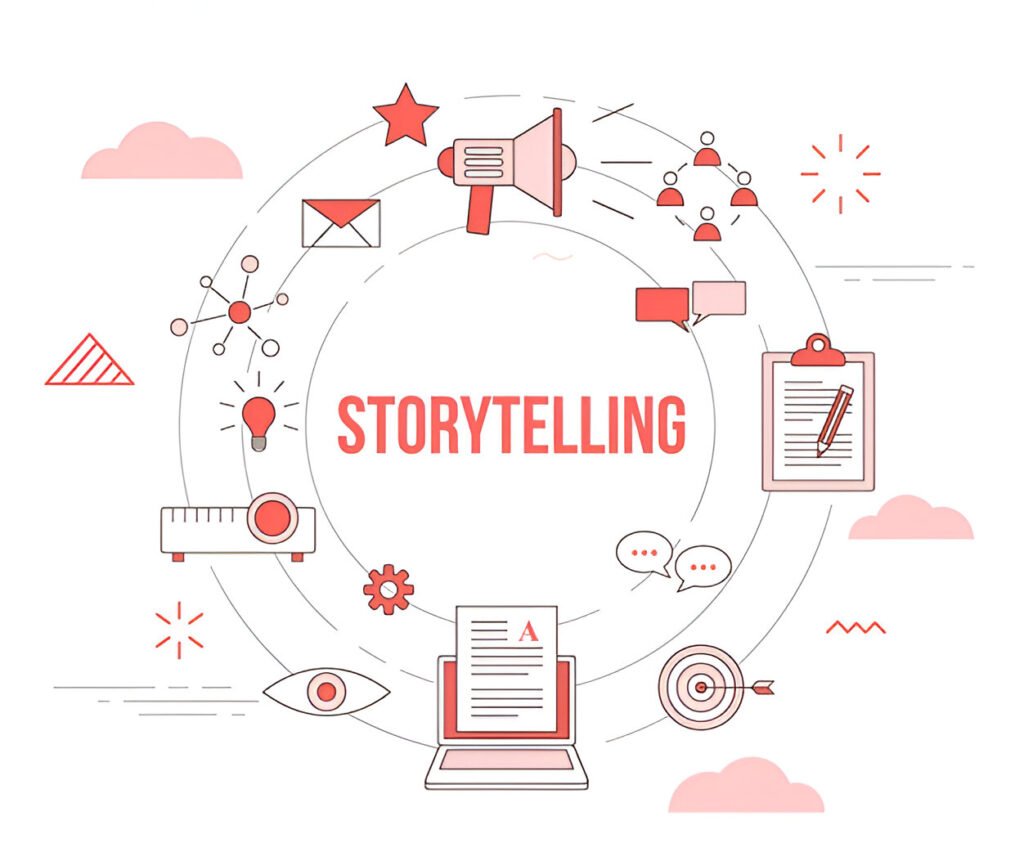Role of Storytelling in Emotional Marketing

Storytelling is not just a creative technique—it’s a strategic approach to emotionally connect with audiences. In the world of emotional marketing, storytelling plays a crucial role by transforming facts into feelings. It allows brands to craft messages that do more than inform—they inspire, touch hearts, and spark action.
Let’s explore how storytelling shapes emotional marketing and why it’s one of the most powerful tools a brand can use today.
What Is Emotional Marketing?
Emotional marketing is about creating a response to influence the behaviour of a consumer. It appeals to emotions such as happiness, fear, anger, love, nostalgia or belonging. You want that connection to be so strong that your audience won’t just remember your brand — they will feel something about it.
While not neglecting features or logic, emotional marketing leverages feelings to create trust and loyalty. And that’s where the story comes into its own.
To fully understand the role of storytelling, it’s also helpful to explore the different types of emotions used in marketing.
Why Storytelling Works in Emotional Marketing
The Human Brain Loves Stories
We are all hard-wired to respond to stories. Neurologically speaking, a well-told story triggers more brain activity than facts alone. When we listen to stories we quite frequently put ourselves into them taking on empathy and engagement.
That is precisely what emotional marketing wants: connection. Storytelling is the bridge that makes that relationship organic and intuitive.
Stories Give Context to Emotions
For example, say you want to promote a line of fitness products. You don’t go through the product features, no — you go on a journey where someone went from being insecure, to becoming disciplined and ultimately achieving what they want with your brand’s help.
It tells a story that your audience can connect with emotionally—struggle, hope, and victory.
Storytelling Shapes Brand Identity
Building Relatable Narratives
Behind every good brand there is a story. It could be the tale of the founder who began in a garage. Or a mission-driven quest to help make the world a better place. All of these stories make the brand feel real and human.
When people can identify with a brand’s journey, values or struggles, they’re more likely to build emotional connections. Storytelling provides companies a way of communicating those values in an authentic way.
Creating Consistency Across Channels
One of the strengths of storytelling in emotional marketing is consistency. A clear narrative lets your brand message stay uniform across websites, ads, social media, and even packaging.
This consistency builds familiarity. And in marketing, familiarity leads to trust—especially when wrapped in emotionally compelling stories.
Emotional Triggers in Brand Storytelling
Nostalgia
Stories rooted in memory and simpler times can transport audiences emotionally. A campaign that reminds people of their childhood or earlier life moments can create a warm, comforting feeling.
Empathy
Highlighting real struggles and showing how your product or service helped can activate empathy. This is particularly strong in healthcare, non-profits, and lifestyle brands.
Hope and Motivation
Inspirational stories are the cornerstone of emotional storytelling. Brands that show transformation, possibility, or resilience can spark hope—a key motivator in human behavior.
Case Examples That Prove the Power of Storytelling
Nike: “Find Your Greatness”
Nike has long moved past simply selling shoes. In their campaigns, they tell stories of ordinary people achieving extraordinary things. Their message? Greatness isn’t reserved for a select few—it lives in everyone.
This storytelling approach triggers motivation, determination, and inspiration. It speaks to the emotional core of their audience.
Dove: “Real Beauty”
Dove’s “Real Beauty” campaign centered around telling stories of real women, challenging traditional beauty norms. By sharing personal experiences and emotional moments, Dove turned a soap ad into a global conversation about self-worth and identity.
How to Build Emotional Stories in Marketing
Start With a Character
Your story needs a central figure—someone your audience can connect with. This character could be a real customer, an employee, or a fictional representation of your target user.
Focus on Conflict and Resolution
Good stories have challenges. They show struggle and then offer a path to a solution. In marketing, this path often leads to your product or service—but it should do so subtly.
Use Real Emotions, Not Forced Drama
Authenticity matters. Audiences can sense when emotions are exaggerated or fake. Stay true to real experiences and real people. That honesty builds credibility and emotional impact.
Storytelling in the Digital Age
Digital marketing has opened up new opportunities for storytelling — Instagram reels, YouTube shorts, blog posts, TikTok videos, all of them are platforms where short-form emotional stories can thrive.
All three of these channels bring fast, relatable relatable and visually interesting stories to life. Marketers might use them to dissect stories into bite-size pieces, or episodes, to engage audiences over time.
For email marketing, a campaign may be a story over emails. The “About Us” section on websites can be turned into a compelling brand origin story. The potential is ever-expanding — if you’re serious about emotion, not just exposure.
Why Consumers Remember Stories Over Facts
Here’s the reality: Facts fade; feelings endure. Most don’t even retain phone specs or gym shoe weights three days later. But they will remember how a campaign felt.
Emotional narrative is not only assistive with awareness. It raises recall, brand preference, and customer return. In a saturated space, it can help your message cut through the noise.
The Ethical Side of Emotional Storytelling
Emotion can be potent — but it must be wielded responsibly. Playing with emotions to capitalize on quick conversions can also backfire, causing brand trust to weaken. When it comes to emotional storytelling, truth, respect, and empathy are always the bottom lines.
And when done with integrity, storytelling creates connections that outlast transactions. It earns loyalty. It builds communities. It’s a brand maker that people don’t just buy from — they believe in.
Final Thoughts
Make no mistake: Storytelling in emotional marketing is an imperative, not just a trend. That’s how brands turn transactional relationships into those based on emotion. It is how they make customers fans, and products movements.
I promise you that by simply operationalizing this knowledge of your audience’s emotions and harnessing the power of storytelling in order to fulfill that need, you’re no longer just taking; you’re part of their tribe. And in advertising, connection is vital.





